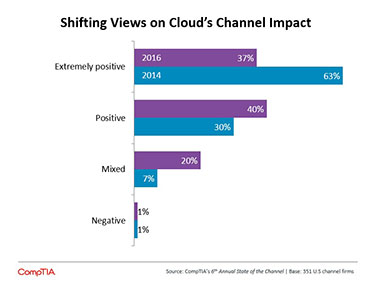 Every once in a while, a reality check hits you. Is my kid really Harvard material? Will I ever fit into my 10-year-old clothes again? Am I honestly cut out to run this bed and breakfast? It’s what we do as human beings...second-guessing, tinkering, course-correcting.
Every once in a while, a reality check hits you. Is my kid really Harvard material? Will I ever fit into my 10-year-old clothes again? Am I honestly cut out to run this bed and breakfast? It’s what we do as human beings...second-guessing, tinkering, course-correcting.
Reflective thinking is also the smart way to operate a business, though not always a pleasant exercise.
Just ask practitioners in the IT channel. Their current reality check revolves around whether cloud computing is having a positive or negative impact on them and their businesses. No black or white answer there. In fact, CompTIA’s 6th Annual State of the Channel study exposes more confusion than conclusion. On the one hand, 4 in 10 channel firms say cloud and its business potential is the No. 1 reason to be optimistic about the channel’s future. On the other, a third of channel firms cite cloud as a main reason to think negatively about the days ahead.
 The disconnect speaks to one of the most notable takeaways from this year’s study: the channel still isn’t all that comfortable with cloud. In fact, they are less sure about cloud’s impact than they were two years ago. It seems, after several years of aggressive cloud activity, the channel has entered what we like to call the “refinement” phase with cloud.
The disconnect speaks to one of the most notable takeaways from this year’s study: the channel still isn’t all that comfortable with cloud. In fact, they are less sure about cloud’s impact than they were two years ago. It seems, after several years of aggressive cloud activity, the channel has entered what we like to call the “refinement” phase with cloud.
Consider the data. This year just 37% of channel firms described the cloud’s impact on the channel in the last five years as “extremely positive.” That is a stark reversal from 2014, when 63% offered such a glowing assessment. Perhaps even more telling is the portion of respondents that say that cloud has had at least a partially negative impact on the channel. In 2014, 8% fell into the naysayer category; in 2016, the somewhat-discontented camp grew to 21%.
Another indicator that channel firms are feeling less comfortable with their cloud decisions to date can be found in how they self-assess their business’ maturity level with cloud. In 2014, for example, 57% of respondents pegged their cloud business as mature and strategic; this year that number dropped to 34%. Instead, the bulk (49%) of channel firms described their current experience with cloud as somewhat mature, while another 14% said their cloud efforts remain in pilot stages. Encouragingly, of the group that reported low levels of cloud maturity, nearly 8 in 10 said they are confident or somewhat confident that they are on the right path with the cloud efforts.
Another stress point for the channel has been the self-service aspect of cloud solutions. End customers today are able to easily click-to-provision a SaaS application or compute capacity directly over the Web from a public cloud provider such as Amazon Web Services or Google. Likewise, many channel firms have feared that vendors selling cloud solutions would begin doing so via direct sales, siphoning off potential revenue for the channel and diminishing their relevance with end customers.
There may be some truth to those concerns. When asked how cloud computing has impacted their relationship with their end customers, this year’s responses mark yet another downward shift from those provided in 2014. While 7 in 10 channel firms said cloud had generally strengthened their ties with end customers two years ago, 6 in 10 did so this year. What is more troubling, however, is the increase in those that believe cloud has weakened customer bonds: 17% felt that way in 2014, 24% do so today.
All of this data suggest an element of “having bitten off more than one can chew” by the channel. Firms that two or three years ago dove headlong into a number of different cloud offerings or business types are now, in hindsight, realizing that they did not foresee some of the challenges. Did they pick the proper cloud business model to fit their skills, size and customer demographics? Did they choose the right cloud vendor partners to work with? Did they determine the right pricing strategy and calculate time to ROI effectively? Falling short in any of these areas could lead many a channel player to pump the brakes a bit before determining how next to proceed.
How a company found its way into cloud is an important dynamic to consider. The study found that 29% of respondents attribute their path to maturity to starting out as a “born in the cloud” company. These cloud natives are not encumbered by a legacy hardware and other on-premises solutions portfolios. As such, they do not need to undergo the costly and difficult “business transformation” process that many traditional channel players are currently struggling with in order to adopt cloud.
Clearly, the cloud market is not going away and will continue growing rapidly. For the SaaS space alone, Gartner is forecasting growth of 20.3% in 2016, to $37.7 billion. And despite all its challenges, the channel itself is seeing its cloud revenues growing at a faster pace than legacy lines of business. But growing pains are growing pains. And if this year’s study results show anything, it’s reality check time for the channel.

 Add CompTIA to your favorite RSS reader
Add CompTIA to your favorite RSS reader
